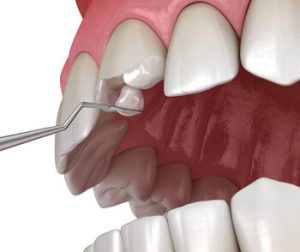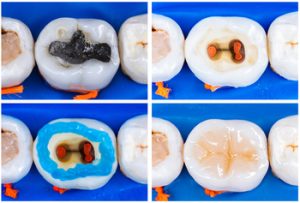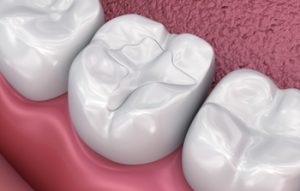Composite bonding has become one of the most popular alternatives to more invasive cosmetic procedures like veneers or crowns. It’s fast, affordable, and minimally invasive. It offers patients a subtle yet transformative improvement to their smile. But a common question many patients ask is: How long does composite bonding last?
In this guide, we’ll break down everything you need to know about the composite bonding procedure, including its lifespan, how to make it last longer, factors that affect durability, and how it compares with other cosmetic dental treatments.
What Is Composite Bonding?
Composite bonding (also called dental bonding or tooth bonding) is a cosmetic procedure that involves applying a tooth-coloured composite resin to the tooth surface. This versatile treatment can:
- Repair chips and cracks
- Close small gaps
- Lengthen short teeth
- Reshape teeth
- Improve the overall appearance of discoloured or uneven teeth
The composite material used is a blend of plastic and glass particles that mimics the appearance of natural tooth material, making it ideal for subtle, aesthetic enhancements.
How Does the Composite Bonding Procedure Work?
 The composite bonding treatment is typically completed in a single visit to the dentist’s office, making it both convenient and time-efficient.
The composite bonding treatment is typically completed in a single visit to the dentist’s office, making it both convenient and time-efficient.
Here’s what you can expect:
- Preparation: No drilling is needed unless the bonding is being used to fill a cavity. A conditioning liquid is applied to help the bonding material adhere to the tooth’s surface.
- Application: The dentist applies the composite resin material to the target tooth, sculpting it to the desired shape.
- Curing: A specific light is used to harden the material.
- Polishing: The bonded tooth is trimmed and polished to match the sheen of your natural teeth.
It’s a minimally invasive treatment that doesn’t typically require anaesthesia and preserves the integrity of your natural tooth structure.
So, How Long Does Composite Bonding Last?
On average, composite bonding lasts between 4 and 8 years, though this can vary based on a range of factors, including:
- The location of the bonded tooth
- How much of the entire surface was bonded
- Your oral hygiene habits
- Your diet and lifestyle
- The quality of the bonding materials used
- The experience of your dentist
With proper care, some composite teeth can last even longer, though they may eventually need minor touch-ups or re-bonding.
Important Factors That Affect How Long Composite Bonding Lasts
Several key elements influence how durable your bonding will be.
1. Location in the Mouth
Bonded teeth at the front of the mouth, which are used less for chewing, tend to last longer. Those at the back are more likely to wear down due to bite pressure.
2. Biting and Eating Habits
Frequent chewing on hard foods like ice or pens can shorten the life of your bonding. Avoiding tobacco products and limiting staining substances like red wine, coffee, and dark sauces will also help keep the material looking good.
3. Oral Hygiene Practices
Maintaining good oral hygiene practices, like brushing with a soft-bristled brush and using a non-abrasive toothpaste, can protect both your natural teeth and the bonded material.
4. General Oral Health
Patients with underlying tooth decay or gum disease, or poor enamel condition may experience shorter bonding lifespan, as the surrounding environment isn’t stable for the material to adhere long term.
How Does Composite Bonding Compare to Porcelain Veneers?
Both composite bonding and porcelain veneers are popular options for enhancing your smile, but they differ in several key areas. Here’s how they compare:
Lifespan
- With the right care routine, composite bonding usually remains effective for 4 to 8 years.
- Porcelain veneers tend to be more durable, often lasting 10 to 15 years or longer.
Invasiveness
- Bonding is minimally invasive and usually doesn’t require altering the tooth structure.
- Veneers require enamel removal, making them a more permanent and involved treatment.
Cost
- Since composite bonding tends to cost less than veneers, it’s a practical option for budget-conscious patients.
- Veneers are more expensive, reflecting their durability and customisation.
Durability
- The composite material is strong but not as resilient as porcelain.
- Porcelain is highly durable and more resistant to wear and tear.
Repairability
- Bonded teeth are easy to touch up or repair in one visit.
- Damaged veneers usually need complete replacement.
Appearance
- Bonding offers a natural look, though it may stain over time.
- Veneers are more stain-resistant and maintain their colour longer.
Many patients choose composite bonding because it’s affordable, reversible, and well-suited for minor cosmetic improvements. If you’re looking for a more conservative option to improve healthy teeth, bonding is an excellent choice. For those wanting longer-lasting, highly polished results, and are comfortable with a more permanent change, porcelain veneers may be worth considering.
How Many Teeth Can Be Bonded?
There’s no set limit. Composite bonding treatment can be done on a single bonded tooth or across multiple teeth as part of a smile makeover. Some people bond just one or two composite teeth to fix chips or gaps, while others might enhance six to ten for a fuller, more uniform look.
The number of teeth you choose to bond will influence the total composite bonding cost, and your dentist can help tailor a plan based on your aesthetic goals and budget.
How Much Does Composite Bonding Cost in Australia?
 The composite bonding cost in Australia typically starts at $300 per tooth, depending on factors like:
The composite bonding cost in Australia typically starts at $300 per tooth, depending on factors like:
- The number of teeth treated
- The extent of reshaping or coverage
- The dentist’s experience
- The practice’s location
It’s considered one of the more affordable cosmetic dental treatments, especially when compared to veneers or crowns. Some clinics also offer composite veneers, which involve covering more of the tooth surface for a more dramatic transformation. These still use composite resin, but are applied across the entire surface of each tooth.
How to Prolong the Life of Your Bonding
Here’s how to keep your bonding material looking good and lasting as long as possible:
- Brush twice daily with a non-abrasive toothpaste
- Use a soft-bristled brush
- Floss daily to prevent tooth decay
- Avoid staining substances like red wine, coffee, tea, and tobacco
- Don’t bite on hard objects (like pens or fingernails)
- Wear a nightguard if you grind your teeth
- Visit your dentist regularly for professional cleans and check-ups
Does Composite Bonding Require Extra Maintenance?
Not particularly. Apart from avoiding behaviours that wear down the composite resin, your routine dental care remains the same. No extra products or long recovery time are needed.
However, keep in mind that composite bonding is not as stain-resistant as enamel or porcelain veneers. Over time, staining substances may dull the appearance of the composite material, but professional polishing by your dentist can usually restore its brightness.
Is Composite Bonding Right for You?
 Composite bonding is ideal for patients with:
Composite bonding is ideal for patients with:
- Small chips or cracks in the teeth
- Uneven edges
- Mild misalignment
- Minor discolouration
- Small gaps between teeth
It’s especially popular among patients who want to improve the look of their smile without permanently altering their natural tooth structure. Because it’s minimally invasive, it offers a flexible, low-commitment solution that blends beautifully with natural teeth.
However, for those seeking maximum longevity, porcelain veneers or other cosmetic dental solutions may be more appropriate. It all depends on your personal goals, dental condition, and lifestyle.
Final Thoughts: Composite Bonding That Lasts
So, how long does composite bonding last? With proper care, the right habits, and regular dental visits, you can expect your bonded teeth to look great for 4 to 8 years, sometimes longer. While not permanent, the ease and versatility of cosmetic bonding make it an outstanding option for those wanting a smile refresh without committing to more intensive cosmetic dental treatments.
If you’re wondering whether composite bonding is right for your smile goals or want a minimally invasive way to restore confidence in your teeth, book a consultation with us at Riverlands Dental or call (02) 4501 7930. We’d be happy to talk through your options and help you achieve a natural, long-lasting result.
Resources
Seed, S. (2023). ‘Bruxism (Teeth Grinding): How Do I Stop It?’. WebMD, 14 December. New York, NY: WebMD LLC. https://www.webmd.com/oral-health/teeth-grinding-bruxism
Watson, S. (2024). ‘Gingivitis and Periodontal Disease (Gum Disease)’. WebMD, 9 February. New York, NY: WebMD LLC. https://www.webmd.com/oral-health/gingivitis-periodontal-disease
WebMD Editorial Contributors. (2023). ‘Teeth Bonding’. WebMD, 2 April. New York, NY: WebMD LLC. https://www.webmd.com/oral-health/dental-bonding



